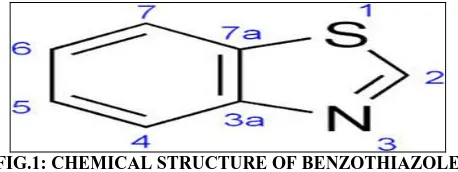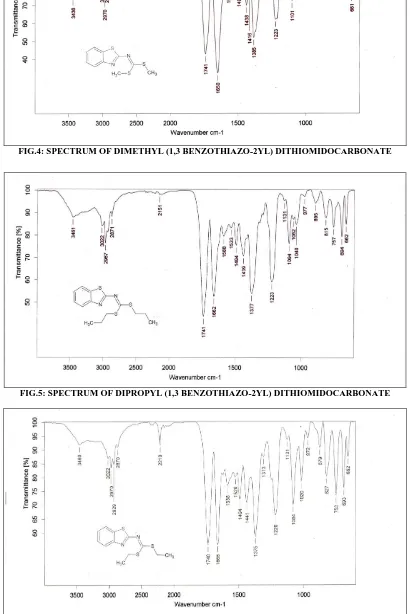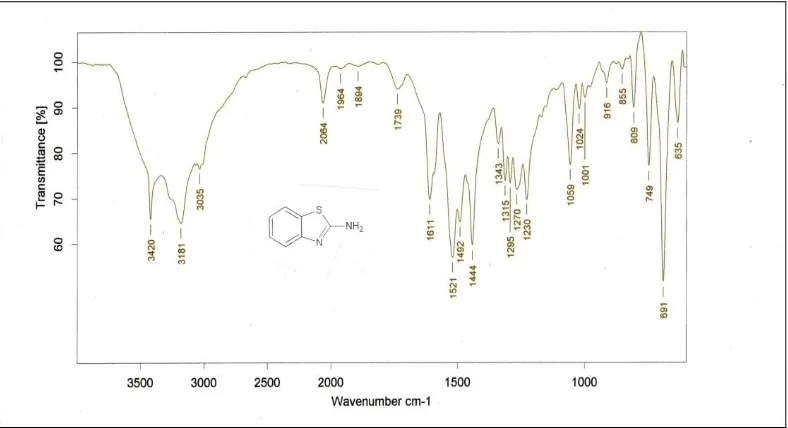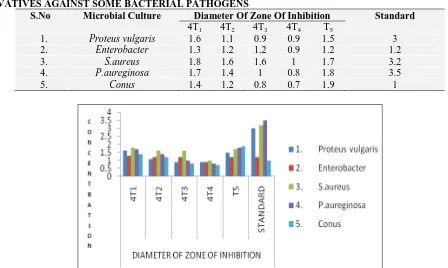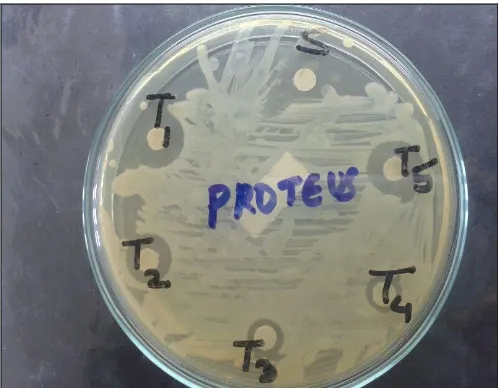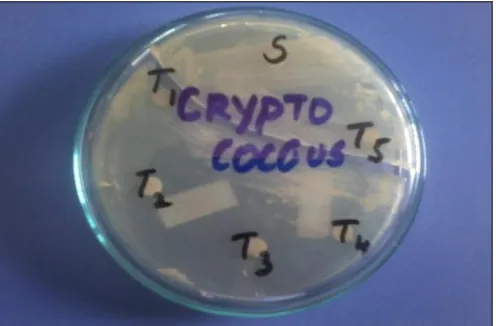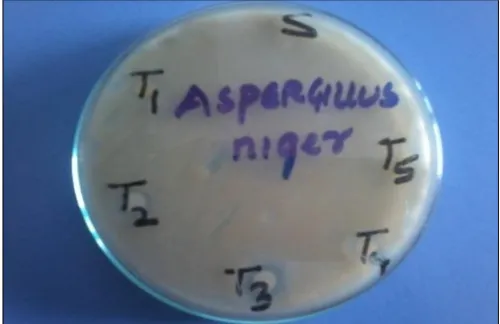IJPSR (2015), Vol. 6, Issue 9 (Research Article)
Received on 08 March, 2015; received in revised form, 18 April, 2015; accepted, 21 June, 2015; published 01 September, 2015
SYNTHESIS AND PHARMACOLOGICAL EVALUATION OF 2-SUBSTITUTED
BENZOTHIAZOLE DITHIOMIDOCARBONATE DERIVATIVES
Tasleem
Department of Pharmaceutical Chemistry, School of Pharmacy, Deccan Group of Institutions, Aghapura, Nampally, Hyderabad-500001, Telangana, India
ABSTRACT: A series of novel 2- substituted benzothiazole dithiomidocarbonate derivatives were synthesized by the reaction of 2-amino benzothiazole with various halides. The test compounds were screened for their antimicrobial activity (antibacterial and antifungal) by disc diffusion method and the results of the microbial activity indicates that the test compounds exhibited varying degree of antimicrobial activity. Among the substituents benzyl moiety exhibited the most potent
activity and the compound Dibenzyl (1,3 benzothiazo-2yl)
Dithioimidocarbonate(4T1) emerged as the most active antimicrobial
agent and it is equipotent when compared to the reference standard Ciprofloxacin. Among the substituents propyl moiety exhibited the most potent activity and the compound Dipropyl (1,3 benzothiazo-2yl)
Dithioimidocarbonate (4T3) emerged as the most active antifungal agent
and it is equipotent when compared to the reference standard Fluconazole.
INTRODUCTION: Heterocyclic compound is a cyclic compound in which the ring atoms are of carbon and some others elements. The atoms of other elements (Nitrogen, Oxygen, Sulphur) are called as heteroatoms. Heterocyclic compounds are widely distributed in nature and plays a diverse and important role in the field of pharmaceutical chemistry. Heterocyclic compounds have a wide range of application in the field of pharmaceutical, agrochemical and veterinary products. They are also used as optical brightening agents, antioxidants, solvents, dye stuffs, and pigments. Heterocyclic compounds are also finding an increase use as intermediates in organic synthesis.
QUICK RESPONSE CODE
DOI:
10.13040/IJPSR.0975-8232.6(9).4058-68
Article can be accessed online on: www.ijpsr.com
DOI link: http://dx.doi.org/10.13040/IJPSR.0975-8232.6(9).4058-68
One such prominent heterocyclic system is benzothiazole with several of its derivatives exhibiting diversified biological activity.1-8 Benzothiazole is one of the most important heterocyclic compound, weak base, having varied biological activity they are widely found in bioorganic and medicinal chemistry with application in drug discovery.
Benzothiazole moieties are part of compounds showing numerous biological activities such as antimicrobial, anticancer, antihelminthic, anti-diabetic activities etc. They have also found application in industry as anti-oxidants, vulcanizations accelerators. Various benzothiazoles such as 2-substituted benzothiazole received much attention due to unique structure and its uses as radioactive amyloidal imaging agents, and anticancer agents. Benzothiazole is an aromatic heterocyclic compound with the chemical formula Keywords:
Dibenzyl (1,3 benzothiazo-2yl) Dithioimidocarbonate, antimicrobial
agent, Ciprofloxacin, Dipropyl (1,3 benzothiazo-2yl) Dithioimidocarbonate,
antifungal agent
Correspondence to Author: Tasleem
Assistant Professor
Department of Pharmaceutical Chemistry, School of Pharmacy, Deccan Group of Institutions, Aghapura, Nampally, Hyderabad-500001, Telangana, India
C7H5NS. Benzothiazole consists of a 5-membered 1,3thiazole ring fused to a benzene ring.9-16
FIG.1: CHEMICAL STRUCTURE OF BENZOTHIAZOLE
MATERIALS AND METHODS:
[image:2.612.59.288.95.181.2] [image:2.612.42.571.249.703.2]The following chemicals are used in the present work.
TABLE 1: LIST OF CHEMICALS
S. No Name Grade Company
1. Aniline AR Sd-fine Chemicals 2. Dimethyl formamide AR Sd-fine
Chemicals 3. Carbondisulfide AR Sd-fine
Chemicals 4. Methyl iodide AR Aldrich
Chemicals 5. Aniline AR Sd-fine
Chemicals 6. Ethanol AR MERCK 7. Benzyl chloride AR Sd-fine
Chemicals 8. Sodium hydroxide AR Sd-fine
Chemicals 10. Methanol AR Sd-fine
Chemicals 11. Petroleum ether AR Sd-fine
Chemicals 12. Ethyl acetate AR Sd-fine
Chemicals 13. Chloroform AR Sd-fine
Chemicals 14. Bromo Ethane AR Sd-fine
Chemicals 15. Bromo propane AR Sd-fine
Chemicals
Chemistry:
Reagent grade chemicals were used without further purification. All the melting points were taken in open capillary tubes and are uncorrected. The purity of the synthesized compounds was checked by Thin Layer Chromatography. IR spectra were scanned on Perkin Elmer Model 283B and Nicolet-740 F T-IR instruments and values are given in cm-1. 3. Each reaction was monitored by TLC by using appropriate solvent system, which was selected by trial and error method. Precoated TLC plates (0.25mm silica gel) were obtained from E. Merck. All solvents extracts were washed with water, brine, dried over anhydrous Na2SO4 and concentrated at reduced pressures on Buchi-R-3000 rotary evaporator below 50°C.
Experimental Procedures:
Synthesis of 2-Aminobenzothiazole (3):
Aniline (0.1mol) was taken in a R.B.F. fitted with condenser & a mixture of HCl (9ml) & water (25ml) was added & then it was heated for about 30min. To the solution of aniline HCl obtained was cooled down to room temp & ammonium thiocyanate (0.1mol) was added. The reaction mixture was refluxed for 4 hr.
The solid separated out on cooling was filtered, washed with water, dried and crystallized from ethanol. To the solid product bromine in chloroform was added with continous stirring. Later the solution was neutralized with ammonia. The formed solid product (3) was re crystallized with ethanol.
NH2
HCL/H2O
NH4SCN
NH NH2
S
Br2in CHCL3
liq NH3
S N H NH2 (1) (2) (3)
Molecular formula: C7H8N2S; Molecular weight: 152;
Melting Point: 120-135 0C; Solubility: Chloroform; Rf: 0.36; Percentage yield: 82%;
Synthesis of Dibenzyl (1,3 Benzothiazo-2yl) Dithioimidocarbonate:
S
N
NH2
CS2 , DMF
C6H5Cl
S
N N
S
S
2-amino benzothiazole (0.025 mole) and aqueous sodium hydroxide solution (10M, 4ml) were stirred in 10 ml of dimethyl formamide for 15 mins then drop wise carbon disulphide was added the reaction mixture was stirred for additional 20 min and then benzyl chloride (0.05 mole) was added and was allowed to stir for 3hrs.The reaction mixture was monitored with TLC.
Molecular formula: C20H16N2S3; Molecular weight: 332; Rf : 0.76;
Melting Point: 140-152 0C; Solubility: Chloroform; Yield: 79.5; IR (KBr)cm-1: 3461 C-H (Stretching of
Aromatic Ring) 2220 C=N ( Thiazole )1568 C=C ( Aromatic Ring)693 C-S
Synthesis of Dimethyl (1,3 benzothiazo-2yl) Dithioimidocarbonate:
S
N
NH2
S
N
N
S
S C
H3 CH3
CS2 , DMF
CH3I
2-amino benzothiazole (0.025 mole) and aqueous sodium hydroxide solution (10M, 4ml) were stirred in 10 ml of dimethyl formamide for 15 minutes drop wise carbon disulphide was added then reaction mixture was stirred for additional 20 min and then methyl iodide (0.05 mole) was added and allowed to stirred for 3hrs. The reaction mixture was monitored with TLC.
Molecular formula: C10H12N2S3; Molecular weight: 208;
Melting Point: 130-140 0C; Solubility: Chloroform; Rf: 0.8; Yield: 81%;
IR(KBr)cm-1 : 2938 C-H (Aliphatic Alkane ) 3010
C-H ( Aromatic )1571 C=C ( Aromatic)694 C-S (Aliphatic Chain)710-550 C-S
Synthesis of Dipropyl (1,3 benzothiazo-2yl) Dithioimidocarbonate:
S
N
NH2
S
N N
S
S
C
H3 CH3
CS2 , DMF
C3H7Br
FIG.1: SYNTHESIS OF DIPROPYL (1,3 BENZOTHIAZO-2YL) DITHIOIMIDOCARBONATE.
2-amino benzothiazole (0.025 mole) and aqueous sodium hydroxide solution (10M, 4ml) were stirred
reaction mixture was stirred for additional 20 min and then bromopropane (0.05mole) was added and was allowed to stir for 3hrs.The reaction mixture was monitored with TLC.
Molecular formula: C14H20N2S3; Molecular weight: 264; Rf: 0.82;
Melting Point: 140-150 0C; Solubility: Chloroform; Yield: 83%;
IR (KBr)cm-1:2151 C-H 1223 C-C (Aliphatic)
1588 C=C (Aromati C) 694 C-S
Synthesis of Diethyl (1,3 benzothiazo-2yl) Dithioimidocarbonate:
S
N
NH2
S
N N
S
S
C H3
CH3
CS2 , DMF
[image:4.612.119.495.200.289.2]C2H5Br
FIG.2: SYNTHESIS OF DIETHYL (1,3 BENZOTHIAZO-2YL) DITHIOIMIDOCARBONATE.
2-amino benzothiazole (0.025 mole) and aqueous sodium hydroxide solution (10M, 4ml) were stirred in 10 ml of dimethyl formamide for 15 minutes then carbon disulpide was added drop wise the reaction mixture was stirred for additional 20 min and then bromo ethane (0.05mole) was added and allowed to stir 3hrs .the reaction mixture was monitored with TLC
Molecular formula: C12H16N2S3; Molecular weight: 236; Rf: 0.39;
Melting Point: 152-160 0C; Solubility: Chloroform; Yield: 82%;
IR(KBr)cm-1 :2870 C-H ( Aliphatic )1588 C-C
(Aromatic)693 C-S972 H-C-S1220 C-C
TABLE 2: PHYSICAL DATA OF SYNTHESIZED COMPOUNDS
Compounds Molecular formula Molecular weight Percentage yield Melting point (oC)
3T C7H8N2S 152 82% 120-135
4T1 C20H16N2S3 332 79.5% 140-152
4T2 C10H12N2S3 208 81% 130-140
4T3 C14H20N2S3 264 83% 140-150
[image:4.612.55.548.437.747.2]4T4 C12H16N2S3 236 82% 152-160
FIG.4: SPECTRUM OF DIMETHYL (1,3 BENZOTHIAZO-2YL) DITHIOMIDOCARBONATE
FIG.5: SPECTRUM OF DIPROPYL (1,3 BENZOTHIAZO-2YL) DITHIOMIDOCARBONATE
[image:5.612.101.511.118.732.2]FIG.7: IR SPECTRUM OF 2-AMINO BENZOTHIAZOLE
Biological Evaluation:
The objective of this work is to try to find out how this group of substituents in benzothiazole exert their antimicrobial activity. The compounds were synthesized were subjected to biological evaluation.
Antimicrobial activity: Test Micro-Organisms:
TABLE 3: LIST OF MICRO-ORGANISMS
S. No. Micro-organisms ATCC Codes I BACTERIA
1 Proteus vulgaris 8427
2 Enterobacter 35030
3 Staphylococcus aureus 25923 4 Pseudomonas aeroginosa 27853
5 Cons 12228
II FUNGI
6 Candida albicans 10231
7 Cryptococci 204092
8 Aspergillusniger 16404
9 Trycophytonrubrum 28188
10 Mucor 16457
Preparation of Antibiotic Stock Solutions:
Ciprofloxacin: Standard stock solution for bacterial organisms. 100mg of ciprofloxacin was dissolved in 100ml of distill water. The stock solution was prepared.
Fluconazole: Standard stock solution for fungal organisms. 1.0 mg/ml of fluconazole diluted with methanol, acetonitrile and buffer (20:10:70). Adjust with glacial acetic acid to a PH of 5.0
Preparation of Test Stock Solution:
The test drugs 2-Aminobenzothiazole (1ml), Dibenzyl (1,3 Benzothiazo-2yl) Dithioimidocarbonate (1ml), Dimethyl (1,3 Benzothiazo-2yl) Dithioimidocarbonate (1ml), Dipropyl (1,3 Benzothiazo-2yl) Dithioimidocarbonate (1ml), Diethyl (1,3 Benzothiazo-2yl) Dithioimidocarbonate (1ml) was dissolved in 10 ml of distilled water.
Anti-microbial susceptibility test: 7 I. Disc diffusion method
Disc Diffusion Method: 7
i. Inoculation of Micro-Organisms:
- Dip a sterile swab into the inoculum tube (5 Bacteria and 5 Fungi).
- Rotate the swab against the side of the tube (above the fluid level) using firm pressure, to remove excess fluid. The swab should not be dripping wet.
- Inoculate the dried surface of a MHA and SA plate by streaking the swab three times over the entire agar surface; rotate the plate approximately 60 degrees each time to ensure an even distribution of the inoculum. - Rim the plate with the swab to pick up any
excess liquid.
- Discard the swab into an appropriate container.
the surface of the agar plate to dry before proceeding to the next step.
ii. Preparation of Dried Filter Paper Discs: Whatmann filter paper no. 1 is used to prepare discs approximately 6 mm in diameter, which are placed in a Petri dish and sterilized in a hot air oven. The loop used for delivering the antibiotics is made of 20 gauge wire and has a diameter of 2 mm. This delivers 0.005 ml of antibiotics to each disc.
iii. Placement of Antibiotic Discs:
- Place the appropriate antimicrobial-impregnated disks on the surface of the agar, using either forceps to dispense each antimicrobial disk one at a time, or a multidisk dispenser to dispense multiple disks at one time.
- Once all disks are in place, replace the lid, invert the plates, and place them in a 37 °c air incubator for 16 to 18 hours (for bacteria) and 7 days (for fungi).
Incubation of Plates:
- A temperature range of 35°C ± 0.5 °C was required.
- Note that temperatures above 35°C may not allow the detection of Organisms.
- Do not incubate plates in CO2 as this will decrease the pH of the agar and result in errors due to incorrect pH of the media. - Results were read after 18 hours (for
Enterobacter, Proteus vulgaris,
Staphylococcus aureus, Pseudomonas
aeroginosa, Conus) and 7days (for Candida albicans, Cryptococci, Aspergillusniger, Trycophyton, Mucor) for incubation.
RESULTS AND DISCUSSION: Antibacterial Activity:
The antibacterial activity of synthetic compounds was tested by using disc diffusion method taking drug at a concentration of 1mg/10ml. The area of zone of inhibition was taken as a parameter of antibacterial activity. The area of zone of inhibition was taken as a parameter of antifungal activity. The area of zone of inhibition of test compound is compared with that of the standard drug i.e., Ciprofloxacin (100 mg/100ml). All the compounds were screened and shown antibacterial activity against following microorganisms Proteus vulgaris, Enterobacter, Staphylococcus aureus, Pseudomonas aeroginosa, Conus.
Measurement of Zone of Inhibition:
TABLE 4: ANTI-BACTERIAL EFFECT OF 2-SUBSTITUTED BENZOTHIAZOLE DITHIOIMIDO CARBONATE DERIVATIVES AGAINST SOME BACTERIAL PATHOGENS
S.No Microbial Culture Diameter Of Zone Of Inhibition Standard 4T1 4T2 4T3 4T4 T5
1. Proteus vulgaris 1.6 1.1 0.9 0.9 1.5 3
2. Enterobacter 1.3 1.2 1.2 0.9 1.2 1.2
3. S.aureus 1.8 1.6 1.6 1 1.7 3.2
4. P.aureginosa 1.7 1.4 1 0.8 1.8 3.5
5. Conus 1.4 1.2 0.8 0.7 1.9 1
[image:7.612.76.524.469.737.2]FIG. 8: ANTI-BACTERIAL ACTIVITY OF SYNTHESIZED COMPOUNDS (CONUS)
FIG. 9: ANTI-BACTERIAL ACTIVITY OF SYNTHESIZED COMPOUNDS (PROTEUS)
FIG. 10: ANTI-BACTERIAL ACTIVITY OF SYNTHESIZED COMPOUNDS (S.AUREUS)
FIG. 11: ANTI-BACTERIAL ACTIVITY OF SYNTHESIZED COMPOUNDS (P.AUREGINOSA)
FIG. 12: ANTI-BACTERIAL ACTIVITY OF SYNTHESIZED COMPOUNDS (ENTERO BACTERIA)
Antifungal Activity:
The antifungal activity of synthetic compounds was tested by using disc diffusion method taking drug at a concentration of 1mg/10ml. The area of zone of inhibition was taken as a parameter of antifungal activity. The area of zone of inhibition was taken as a parameter of antifungal activity. The area of zone of inhibition of test compound is compared with that of the standard drug i.e., Fluconazole (1 mg/ml).
All the compounds were screened for antifungal activity against five fungal organisms, Aspergillus
niger, Candida albicans, SDA mucor,
[image:8.612.48.298.55.250.2] [image:8.612.314.562.55.248.2] [image:8.612.315.562.281.478.2] [image:8.612.48.297.282.476.2] [image:8.612.50.298.511.722.2]TABLE 5: ANTI-FUNGAL EFFECT OF 2-SUBSTITUTED
BENZOTHIAZOLE DITHIOIMIDO CARBONATE DERIVATIVES AGAINST SOME FUNGAL PATHOGENS S.No Microbial Culture Diameter of Zone of Inhibition Standard
4T1 4T2 4T3 4T4 T5
1. A.niger 0.7 1.2 1.5 1.3 0.8 2.0
2. C.albicans 0.9 0.2 0.8 0.9 0.1 1.2
3. SDA.mucor 0.8 0.6 1.9 1.2 0.7 2.5
4. Trychophytonrubrum 0.5 0.1 0.1 0.2 0.1 1.0
[image:9.612.66.537.65.349.2]5. Cryptococci 0.3 0.2 0.1 0.1 0.1 1.5
FIG. 13: BAR DIAGRAM OF ANTI-FUNGAL ACTIVITY OF SYNTHESIZED COMPOUNDS
[image:9.612.316.562.368.530.2]FIG.14: ANTI-FUNGAL ACTIVITY OF SYNTHESIZED COMPOUNDS (CANDIDA ALBICANS)
FIG.15:ANTI-FUNGAL ACTIVITY OF SYNTHESIZED COMPOUNDS (SDA TR)
FIG.16: ANTI-FUNGAL ACTIVITY OF SYNTHESIZED COMPOUNDS (SDA MUCOR)
[image:9.612.49.295.561.750.2] [image:9.612.315.563.565.728.2]FIG. 18: ANTI-FUNGAL ACTIVITY OF SYNTHESIZED COMPOUNDS (ASPERGIUS NIGER)
CONCLUSION: Benzothiazole and its derivatives were synthesized in laboratory by simple methods under normal conditions, with the help of magnetic stirrer. All the compounds were characterized by spectral methods like IR Spectroscopy.
The synthesized compounds were screened for their anti-microbial activity by using nutrient agar media & sabouraud’s glucose agar media by disc diffusion method. Some of these compounds showed significant activity against gram positive and gram negative bacteria and fungi.
The proposed compounds were synthesized successfully and characterized. They were evaluated for their antimicrobial activity and the results were found to be encouraging. Most of the compounds were more active against gram positive (Proteus vulgaris, Staphylococcus aureus, Pseudomonas aeroginosa) and gram negative (Enterobacter) bacteria and fungi. The promising result in antifungal activity gave us scope for further work in this area.
Antimicrobial Activity:
It was carried out against microorganisms using disc diffusion method. In antimicrobial study compounds 4T2, 4T3, 4T4 exhibited moderate antibacterial activity while 4T1 have emerged as the most active antibacterial agent and it has shown equipotent activity when compared to the reference standard Ciprofloxacin.
Antifungal activity:
It was carried out against microorganisms using disc diffusion method. In antimicrobial study
compounds 4T1, 4T2, 4T4 exhibited moderate antibacterial activity while 4T3 have emerged as the most active antibacterial agent and it has shown equipotent activity when compared to the reference standard Fluconazole.
Future Scope: At last, it is worthwhile to study these compounds further by carrying out complete QSAR and molecular modellling studies and which may establish these compounds as lead molecules for antimicrobial activity.
REFERENCES:
1. Vani R and Rasheed A: Formulation and evaluation of Hydrochlorothiazide and Ramipril Mouth Dissolving Tablet using different Superdisintegrants. Int J Pharm Sci Res 2014; 5(1): 207-12.doi: 10.13040/IJPSR. 0975-8232.5(1).207-12.
2. Rasheed A et al., Analytical Method Development and Validation for the Simultaneous Estimation of Aspirin, Clopidogrel Bisulphate and Atorvastatin Calcium in Tablet Dosage Form. American Journal of Pharm Tech Research 2014.
3. Rasheed A, Fathima I and Altaf M: Attention Deficit Hyperactivity Disorder (ADHD): An Overview. Int J Pharm Sci Res 2013; 4(4); 1669-1683.
4. Vani R. et al., Validation and Derivative Spectroscopy of PrasugrelHClIn Bulk and Formulation. American Journal of PharmTech Research 2013.
5. R. Vani, B. Vijaya Kumar, Anas Rasheed; Analytical Development and Formulation of Ramipril and Hydrochlorothiazide in Combination with Selective Excipients, R. Vani, et al. Int J Pharm 2013; 3(2): 348-35. 6. Rasheed A and Farhat R: Combinatorial Chemistry. Int J
Pharm Sci Res 2013: 4(7); 2502-2516. doi: 10.13040/IJPSR. 0975-8232.4(7).2502-16.
7. Rasheed A and QasimMd: A Review of Natural Steroids and their Applications. Int J Pharm Sci Res. 2013; 4(2); 520-531.
8. Altaf et al. Drug Utilisation Evaluation Of Antihypertensives In Geriatric Patients In A Tertiary Care Hospital, Int J Pharm PharmSci, Vol 6, Issue 9, 261-264. 9. Anas Rasheed Mohammed Altaf et al. A Cross-Sectional
Study of Analysis of Knowledge of Diabetes In Diabetic Patients And Patient Counselling In Princess Esra Hospital, IOSR Journal Of Pharmacy (e)-ISSN: 2250-3013, (p)-ISSN: 2319-4219 , www.iosrphr.org Volume 4, Issue 4 (April 2014), Pp 80-93.
10. Delmas F, Avellaneda A, Di Giorgio C, Robin M, De Clercq E&co workers, Eur J Med Chem.; 39(8):685-90, 2004 Aug
[image:10.612.47.297.55.217.2]12. Shafi S, Alam MM, Mulakayala N, Mulakayala C, &co workers, Eur J Med Chem. 2012 Mar;49:324-33. doi: 10.1016/j.ejmech.2012.01.032. Epub 2012 Jan 24. 13. Axford LC, Agarwal PK, Anderson KH, &co workers, Eur
J Med Chem. 2012 Mar; 49:324-33. doi: 10.1016/j.ejmech.2012.01.032. Epub 2012 Jan 24
14. Malik S, Bahare RS, Khan SA &co workers, Bioorg Med ChemLett. 2013 Dec 15; 23(24):6598-603. doi: 10.1016/j.bmcl.2013.10.058. Epub 2013 Nov 4.
15. Ke S, Wei Y, Yang Z, Wang K, Liang Y, Shi L. &co workers, Eur J Med Chem. 2013 Sep; 67:1-13. doi: 10.1016/j.ejmech.2013.06.026. Epub 2013 Jun 18. 16. MacKinnon CH, Lau K, Burch JD, Chen Y, Dines J, Ding
X, &co workers, Bioorg Med ChemLett. 2013 Sep 15; 23(18):5131-4. doi: 10.1016/j.bmcl.2013. 07.023. Epub 2013 Jul 22.
All © 2013 are reserved by International Journal of Pharmaceutical Sciences and Research. This Journal licensed under a Creative Commons Attribution-NonCommercial-ShareAlike 3.0 Unported License.
This article can be downloaded to ANDROID OS based mobile. Scan QR Code using Code/Bar Scanner from your mobile. (Scanners are available on Google Playstore)
How to cite this article:
